
Model Coordinates
Coordinate System for this Lattice Model
This section explains several methods that are used in this paper to describe nucleon and/or quark locations in this “hexagonal lattice/modified alpha cluster/restricted quark model” of the nucleus.
I. With “Notation”
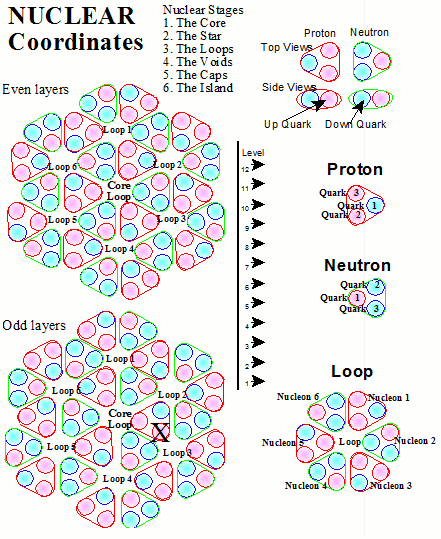 For ease of describing where the nucleons and quarks are located in the
lattice structure of this model, a coordinate system was developed that
is singularly to define the locations of the quarks in this model of a
nucleus. all counting is in a clockwise direction.
For ease of describing where the nucleons and quarks are located in the
lattice structure of this model, a coordinate system was developed that
is singularly to define the locations of the quarks in this model of a
nucleus. all counting is in a clockwise direction.
The notation describing nucleon and quark locations contain six elements.
- The first element designates the nucleon type, �P� for a proton and �N� for a neutron.
- The second element describes the quark �u� for the up quark and �d� for the down quark.
- The third designates the lattice level. Because of balance and symmetry there will always be an even number of levels. For the elements from hydrogen to uranium there are 18 levels ranging from level -2 to level 15. The center of the lattice structure lies between level 6 and level 7. Levels can be considered somewhat analogous to shells. Numbers for this section range from -3 to 16.
- The fourth element designates the loop or which of 7 loops that the nucleon is positioned in. Numbers for this section range from 1 to 7 clockwise.
- The fifth element designates the position the nucleon occupies in the loop. Number are counted in a clock wise direction looking down on the nucleus. Numbers for this section range from 1 to 6 clockwise.
- The sixth describes the position of the quark in the nucleon. Numbers for this section range from 1 to 3 clockwise.
The illustration below is for a reference that would be found in a nucleus that is at least as large as the nucleus of molybdenum.
P,u,7,3,6,2
This refers to one of the “up quarks” in a “proton” that is located on the 7th level in the 3rd loop. That quark is in the 6th nucleon (3rd proton) and occupies the 2nd quark position in that proton.
II. Model Coordinates
The coordinate locations given in the table below correspond to the position shown on the accompanying charts.
These coordinates correspond to the quark positions that could be occupied on each level of the model. By using the coordinates a three dimensional model of the optimum position for each quark and thus for each nucleon can be generated.
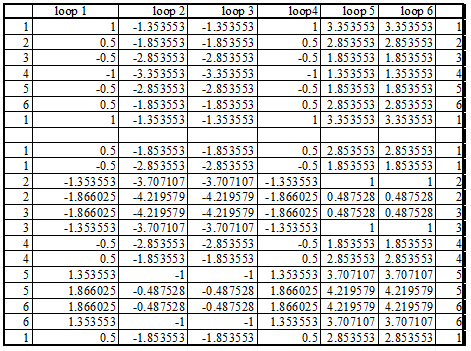
Shown below are the positions described by the above coordinates.
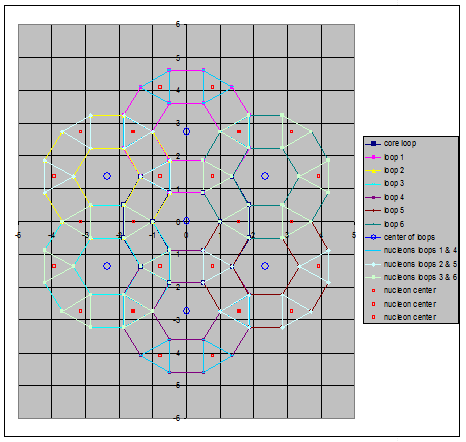
Next is illustrated how quarks might fit into spherical nucleons. The positions, of the quarks as shown within the spherical nucleons, are based on the original coordinates provided above.
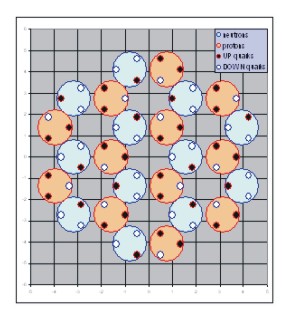
III. With “Illustrations”
The illustrations shown in this paper were primarily derived using the coordinates shown here. They are all consistent within each other, they are just used to look at the model from differing aspects for a more through study. The illustrated figures shown demonstrate that the system uses the same positions as are used in the numeric coordinate system. They are also compatible with all the other systems used and shown in this paper. The various aspects used in this paper provide different ways of viewing the same thing from differing points, aspects, and ways of illustrating the model.
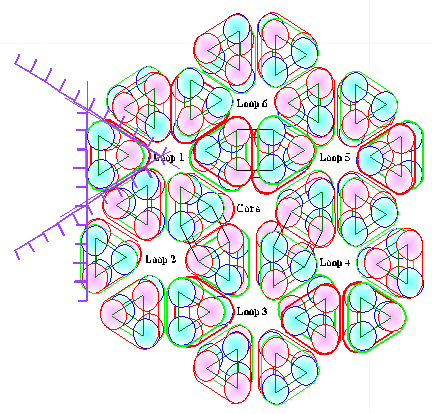

IV. With “Tables” (also see the nuclear periodic table)
The nuclear periodic table helps with the understanding of where the different nucleons are located within the nucleus. The following table shows the basic steps in building the nucleus and it goes hand in glove with the nuclear periodic table. This graph shows how the protons and neutrons are added in the same groupings as shown in the nuclear periodic table. Each step shows how many protons and neutrons are added to �The Core�, �The Star� or �The Loops� portion of the hexagonal lattice structure. Also it demonstrates why eventually proton locations are missed because those locations are buried within the lattice structure . One of the amazing characteristics of this hexagonal lattice is that no where in any stable nuclei is a proton bonded to a proton or a neutron bonded to a neutron!

This table was used to grow the nucleus and also to show how it grows and enlarges through the various stages as elements and isotopes or followed along the valley of stability.
V. With “ZOME”
This is the “ultimate hands on study” of this model and the positions and coordinates are exactly the same as all the other systems. The advantages of a physical model are
 It can be be touched, picked up, and examined
It can be be touched, picked up, and examined- It can be studied and determine what happens as nucleons are added one at a time
- Easier to visualize in three dimensions
- Harder to make mistakes while studying how the nucleus grows.
- Make great models and provide for interesting aspect study.
- They make wonderful toys for the grand kids!
The nucleons align so that there is always a neutron between two protons so that protons always attach to neutrons. This alignment is consistent in both the lateral and vertical directions.
- All even numbered levels have the same position configuration for protons and neutrons.
- All odd numbered levels the protons and neutron switch place from their position on the even levels.
When the nucleus moves into �the voids� phase, levels near the top and bottom of the nucleus are missing protons in the loop and/or star sections of the nucleus and that form the void levels.
Protons and neutrons consist of three quarks and the structure of this model is built around the shape of the three quarks comprising a nucleon. To visualize this lattice structure in a “Tinker Toy” model setting, because actual Tinker Toys are hard to find now this framework was fabricated using nodes and struts obtained from �ZOME� at www.zometool.com
The nodes in this model represent quarks.
 |
The black nodes represent �UP� quarks, with a +2/3 charge. |
 |
The white nodes represent �DOWN� quarks, with a -1/3 charge. |
|
The protons and neutrons are represented by triangular quark constructs. |
|
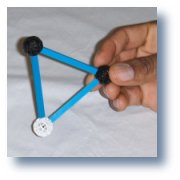 |
The proton is represented by two �UP� quarks, (black nodes, charge +4/3) connected to one �DOWN� quark, (white node, charge -1/3) by blue struts, that has an over all charge of the proton is positive one. |
 |
The neutron is represented by two �DOWN� quark, (white nodes, charge -2/3) connected to an �UP� quark, (black node, charge +2/3) by white struts, over all charge of the neutron is zero. |